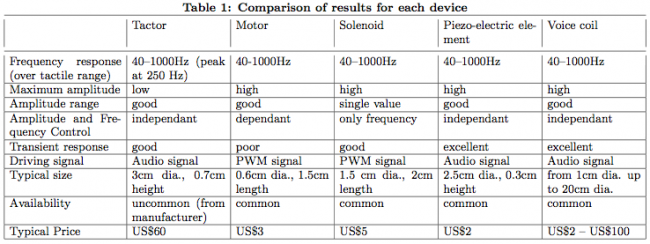
Description:
Tactile feedback is feedback generated through the sensation of touch. Unlike force feedback, it does not involve a force as such but makes use of the sensation of texture and of vibration. In traditional acoustic musical instruments this feedback comes to the performer from the resonating body of the instrument. The performer’s body is in contact with the instrument and so the performer feels the vibrations of the instruments body caused by the generation of sound. With a guitar for instance the performer feels vibration of the strings through the fingertips and the vibration of the guitar body through contact with the torso. Wind performers will feel vibration at the mouthpiece and using their fingers at the toneholes or keys.
One of the advantages of digital musical instruments is that they can separate the sound production mechanism from the control mechanism. This allows a digital musical instrument to produce a range of sounds and to make use of a range of control gestures which would just not be possible for acoustic instruments. For instance it is possible to develop a digital musical instrument which involves no contact between the user and a physical instrument at all (such as the Theremin, Tarabella’s Twin Towers, the Dimension Beam, or instruments developed with camera systems like Eyesweb or Rokeby’s Very Nervous System). Even when the performer is in direct contact with a physical interface, sound production generally takes place through synthesis software on a computer connected to amplifiers and loudspeakers, which are often spatially located away from the performer.
This means that the performer loses at least one channel of feedback from the instrument (in the case of completely non-contact instrument, the performer also loses the haptic feedback from the instrument). Therefore, if we wish to make use of tactile feedback in a digital musical instrument, it is necessary to somehow generate vibrations which the performer can feel.
This project deals with two different forms of vibrotactile feedback. The first form simulates the vibrations of an acoustic instrument. In this case it is necessary to generate tactile feedback which would result from the sound of the instrument, were the instrument generating that sound acoustically. The second form of tactile feedback is perhaps of more use for the non-contact instruments. In this case, the instrument is often more abstract and gesture-based and often involves playing in space. It may therefore be useful to use tactile feedback as a communication channel between the performer and the system, perhaps indicating parameter values or changes, or in the case of movement through space to indicate regional boundaries.
Specifically, this project involves research into the ways in which we can provide vibrotactile feedback in digital musical instruments, both to simulate acoustic instrument vibrations and also to add an extra channel of feedback in non-contact digital musical instruments, aswell as the use of this feedback and its effects on composition and performance.
The project is taking place in collaboration with composer Heather Hindman and cellist Chloe Dominguez and is funded by the Center for Interdisciplinary Research into Music Media and Technology (CIRMMT) and also as part of the Digital Orchestra Project. It is divided into two phases, the first involving an evaluation of devices for creating vibrotactile feedback and the development of prototype instruments which incorporate this feedback to simulate acoustic instrument vibrations and the second involves the development of devices for vibrotactile feedback in non-contact instruments as well as the construction of 2 prototype instruments which make use of this feedback.
IDMIL Participants:
Research Areas:
Funding:
Publications:
- Giordano, M. (2016). Vibrotactile Feedback and Stimulation in Music Performance. In Ph.D. Thesis, McGill University. Montreal, Canada.

